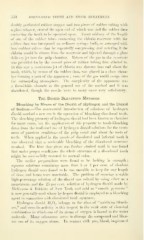Page 552 - My FlipBook
P. 552
550 DISCOLORED TEETH AND THEIR TREATMENT.
doubly perforated rubber stopper and two pieces of rubber tubing with
a glass adapter, around the open end of which was tied the rubber dam
encirclinj^ the tooth to be operated upon. About midway of the lenj:;th
of one of tlie rubber tubes connecting th(> chlorin res(>rvoir with tlie
rubber dam Mas interposed an ordinary syringe bull), so arranged with
hard-rubber valves that by rei)eatedly c()m])r(>ssing and relaxing it the
chlorin would be drawn from the reservoir and injected through a glass
dcliverv j(»t into the pulp (;hamber. Return of the gas to the reservoir
was provided for by the second piece of rubber tubing first alluded to.
In this way a continuous jet of chlorin was thrown into and about the
tooth, which, by means of the rubber dam, was placed in a close cham-
hvY forming a part of the apparatus ; none of the gas could escape into
the surrounding atmosphere. The complexity of the apparatus was
a formidable obstacle to the general use of the method and it was
abandoned, though the results were in many cases very satisfactory.
The Dioxid Bleaching Methods.
Bleaching- by Means of the Dioxid of Hydrog-en and the Dioxid
of Sodium.—The commercial introduction of solutions of hydrogen
dioxid marked a new era in the operation of bleaching discolored teeth.
The bleaching property of hydrogen dioxid had been known to chemists
for many years, but the application of this property to tooth-bleaching
dates from the medicinal use of hydrogen dioxid solutions for the treat-
ment of purulent conditions of the pulp canal and about the roots of
teeth. When applied in the canals of discolored and infected teeth it
was observed that a noticeable bleaching of the discolored structure
resulted. The hint thus given was further studied until it was found
that under proper conditions the whole structure of a discolored tooth
might be successfully restored to normal color.
The earlier preparations were found to be lacking in strength ;
aqueous solutions containing more than 3 or 4 per cent, of absolute
hydrogen dioxid were found to be too unstable to keep for any length
of time, and hence were unreliable. The problem of securing a stable
high-percentage solution of the dioxid was solved by using ether as a
menstruum, and the 25 per cent, solution of hydrogen dioxid made by
"
INIcKesson & Robbins of New York and sold as " caustic pyrozone
is now generally used where hydrogen dioxid is employed as a bleaching
agent in connection with discolored tooth structure.
Hydrogen dioxid, H.O,,, belongs to the class of " oxidizing bleach-
ers," and owes its activity in this respect to the Aveak state of chemical
combination in which one of its atoms of oxygen is bound to the water
molecule. Many substances serve to disrupt the compound and liber-
ate one of its oxygen atoms. In contact w^th pus, blood, inspissated


